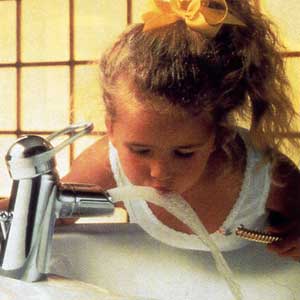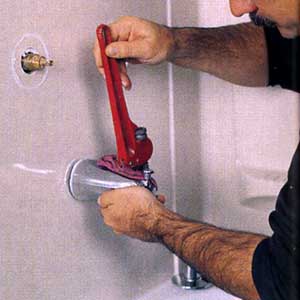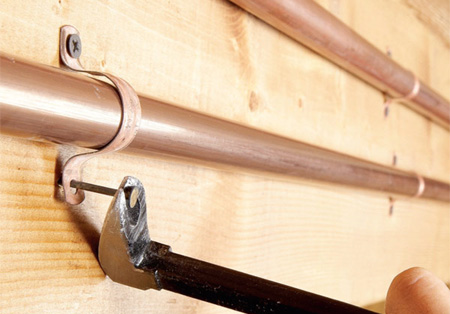It's not enough to just know your toilet is leaking; you also need to know what part is leaking. Here's a list of the most common places inside the tank that can leak into the bowl..
A worn out flapper or ball.
A damaged seat under the flapper.
A damaged gasket under the flush valve.
A hole or crack in the overflow tube.
A refill valve (ballcock) that needs a new seat or washer.
There are a number of signs that a toilet needs some repairs, but many toilets leak without conspicious indications of trouble. Here are some of the more obvious signs of a leaking toilet:
*** If you have to jiggle the handle to make a toilet stop running.
*** Any sounds coming from a toilet that is not being used are sure signs of leaks.
*** If you have to hold the handle down to allow the tank to empty. This can also mean the chain or strap is too long and doesn't lift the flapper or ball high enough to float on its own.
*** If you see water running over the top of the overflow, you definitely have a leaking refill valve. If you are unsure whether or not water is running over the top of the overflow pipe; sprinkle talcum powder on top of the water in the tank, and you can clearly see whether or not it is. A student of Toiletology 101 recently e-mailed me that he sprinkled talcum powder on top of the water in the bowl and it clearly will show water leaking into the bowl.
*** If you can see water trickling down the sides of the toilet bowl long after it's been flushed;
*** If water drips out of the refill tube into the overflow pipe;
*** If a toilet turns the water on for 15 secords or so without you touching the handle, this is otherwise known as the phantom flusher.
However, even if your toilet doesn't have any of these
symptoms, it's still possible that it is leaking. These leaks are known as SILENT LEAKS, because they usually go undetected. There is an easy test you can do that will positively tell you whether or not your toilet is leaking. And if the test shows that the toilet is leaking, there is a second test that tells you what part inside the tank is responsible and needs fixing.
Remove the cover on the toilet tank and carefully set it aside so it can't be accidently knocked over and cracked. Remove any "in-tank" bowl cleaners that color the water and begin the test with clear water in the tank as well as in the bowl.

You'll need some dye. Some municipal water
companies will provide dye capsules or tablets, but food coloring or instant coffee works fine. Another great suggestion from a viewer is to use several tablespoons of a powdered fruit drink mix; grape flavored is perfect. Now put enough dye in the tank water to give the water a deep color. Wait 30 minutes and make sure nobody uses the toilet. In 30 minutes if you find any of the dyed water is now in the toilet bowl -- your toilet is leaking. A properly operating toilet will store water in the tank indefinitely without any water running into the bowl. A student once told me she thought that water was supposed to be running in the toilet bowl to help keep it clean. Another student told me that she thought when you had a leaking toilet there would be water visible on the floor.
Water on the floor around a toilet is certainly a problem. It can be dripping off a sweaty toilet tank during humid weather; it can mean the wax sealing ring under the bowl has disintegrated, or the bowl is cracked; or it can mean the connections under the tank are leaking. (These problems will be covered later.)
So for now, let's say you've done the dye test and found your toilet is leaking, you now have to find out which part is the culprit ... the flush valve or the refill valve. And there's another simple little test that points to the perpetrator of the crime.

Draw a pencil line on the back wall of the tank on the inside of the tank at the waterline. Then turn the water supply off, either under the tank or at the main shutoff ~~ wait 20 to 30 minutes. If the water level remains at the pencil mark ~~ the leak is occuring at the REFILL VALVE, the unit in the left side of the tank. If the water level falls below the pencil mark ~~ the leak is in the FLUSH VALVE, the unit located in the center of the tank.
Photos courtesy Fluidmaster, Inc.
As noted above a leaking toilet should never be ignored; it can be a very costly oversight. The "Dye Test" is so easy to do and so useful that I found it impossible to believe that it was not included in an article published in
USA Today titled, "Tender loving care beats costly home repairs" on 20 January 2006. In the section,
Managing Your Money, the article took up two-thirds of a full page complete with several photos, sidebars and a Month-by-month to-do list. It appeared they covered everything except the toilet! Because a leak inside of a toilet is often not visible or
audible, too many people can't believe their high water bills are due to a neglected toilet. Make sure you add this simple test to
your home maintenance to-do list. If you have determined the leak is at the flush valve and you replace the ball, flapper, seal or whatever and it still leaks, there is one more test to further try and pinpoint the problem. This time turn the water off to the toilet before going to bed. In the morning, check the water level. If there's about an inch in the bottom of the tank and the water level is even with the
edges of the seat, the leak is either a bad stopper (ball, flapper or whatever) or a damaged seat. On the other hand, if the tank is almost entirely empty, and the water level is below the edges of the seat, the problem is a damaged gasket under the flush valve. This means the tank will have to be separated from the bowl in order to get to the connections.
If you don't have more than one bathroom and must use the toilet during the night, flush the toilet with a bucket of water from the bathtub. Fill a scrub bucket with water and dump the water into the bowl all at one time. It will clear the bowl.
source:
http://www.toiletology.com/leaking.shtml
http://www.guaranteedplumbingco.com










 Studies show that dripping faucets and leaking toilets account for as much as 14% of all indoor water use, equivalent to 10 gallons per person of water lost per day.
Studies show that dripping faucets and leaking toilets account for as much as 14% of all indoor water use, equivalent to 10 gallons per person of water lost per day.






